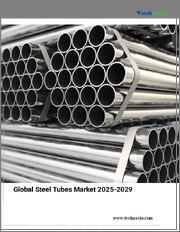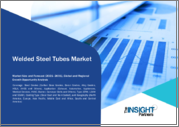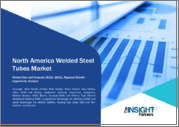
|
시장보고서
상품코드
1543683
세계의 구조용 강관 시장 규모 조사 : 유형별, 재료별, 판매 유형별, 용도별, 지역별 예측(2022-2032년)Global Structural Steel Tube Market Size study, by Type, by Material, by Sales Type, by Application and Regional Forecasts 2022-2032 |
||||||
세계 구조용 강관 시장은 2023년 약 1,053억 달러로 평가되며, 2024-2032년 예측 기간 동안 4.8% 이상의 견조한 성장률을 기록할 것으로 예상됩니다.
중공 구조용 강관(HSS)으로 알려진 구조용 강관은 높은 강도 대 중량 비율과 다양한 용도로 인해 건설 및 구조 응용 분야에서 매우 중요한 역할을 합니다. 직사각형, 정사각형 및 원형 단면으로 제공되며 용접, 이음매없는 압연 및 냉간 인발로 제조되어 정확한 치수와 내구성을 보장합니다. 고유한 특성으로 인해 하중을 견디는 용도에 이상적이며, 강도를 유지하면서 전체 무게를 줄입니다.
구조용 강관은 깔끔한 선과 매끄러운 표면 처리로 인해 건축, 교량, 터널 및 다양한 건축물에 널리 사용되고 있습니다. 또한 산업 기계 및 운송 구조물에도 필수적입니다. 이 튜브의 높은 내구성과 압축, 굽힘 및 비틀림 응력에 대한 내성과 결합하여 장기적인 성능과 재료 사용 효율성을 보장하여 현대 건설 및 엔지니어링에 필수적인 요소로 자리 잡았습니다. 급속한 도시화와 인프라 확장은 전 세계 인프라 프로젝트에 대한 막대한 투자에 힘입어 시장 성장을 촉진하는 주요 요인으로 작용하고 있습니다.
세계 수요와 공급, 지정학적 긴장, 무역 정책에 따라 강재 가격이 변동함에 따라 원자재 가격 변동은 구조용 강관 시장의 주요 억제요인으로 작용하고 있습니다. 이러한 변동은 제조업체의 비용 구조와 수익성에 영향을 미쳐 장기 계획을 복잡하게 만들고 시장 성장을 저해할 수 있으며, COVID-19 팬데믹 상황에서 볼 수 있듯이 세계 공급망에 대한 의존도는 이러한 문제를 더욱 악화시킬 수 있습니다. 이러한 도전에도 불구하고, 특히 아시아태평양, 아프리카, 라틴아메리카의 신흥 시장은 급속한 산업화와 도시화로 인해 큰 성장 기회를 제공하고 있습니다.
전기 저항 용접(ERW) 및 이음매없는 압연과 같은 제조 기술의 발전으로 강관의 내식성과 강도가 향상되었습니다. 디지털 설계 및 모델링 도구의 혁신은 재료 효율성과 구조적 무결성을 더욱 향상시켜 복잡하고 아름다운 구조물의 건설을 용이하게 합니다. 이러한 발전은 건설 및 산업 부문의 진화하는 요구에 부응하기 위해 첨단 구조용 강관의 채택을 촉진하고 있습니다.
이 보고서는 아시아태평양, 북미, 유럽, 라틴아메리카, 중동 및 아프리카를 주요 지역으로 삼았습니다. 아시아태평양은 구조용 강관 시장의 주요 지역인 동시에 가장 빠르게 성장하는 지역이기도 합니다. 이러한 우위는 중국, 인도, 동남아시아 국가 등의 급속한 산업화와 도시화에 힘입은 바 큽니다. 이 지역에서는 정부 이니셔티브와 민간 투자로 인해 건설 및 인프라 개발이 빠르게 진행되고 있으며, 이는 구조용 강관에 대한 수요를 크게 증가시키고 있습니다. 이러한 강관은 고층 구조물, 교량, 산업 시설, 교통망 건설에 필수적이며, 이 모든 것이 이 지역에서 전례 없는 속도로 확장되고 있습니다. 또한, 아시아태평양의 제조업, 특히 세계 최대 철강 생산 및 소비국인 중국의 제조업이 견조한 성장세를 보이고 있어 이 시장에서의 선도적 지위를 더욱 공고히 하고 있습니다. 원자재 가용성, 낮은 인건비, 주요 시장 기업의 존재는 이 지역의 빠른 성장과 구조용 강관 시장에서의 지속적인 우위에 기여하고 있습니다.
목차
제1장 구조용 강관 세계 시장 주요 요약
- 구조용 강관 세계 시장 규모와 예측(2022-2032년)
- 지역별 개요
- 부문별 개요
- 유형별
- 재료별
- 판매 유형별
- 용도별
- 주요 동향
- 불황의 영향
- 애널리스트의 결론과 제안
제2장 세계의 구조용 강관 시장 정의와 조사 가정
- 조사 목적
- 시장 정의
- 조사 가정
- 포함과 제외
- 제한사항
- 공급측 분석
- 입수 가능성
- 인프라
- 규제 환경
- 시장 경쟁
- 경제성(소비자의 관점)
- 수요측 분석
- 규제 프레임워크
- 기술의 진보
- 친환경
- 소비자 의식과 수용
- 조사 방법
- 조사 대상 연도
- 통화 환산율
제3장 구조용 강관 세계 시장 역학
- 시장 성장 촉진요인
- 급속한 도시화와 인프라 확대
- 높은 강도대 중량비와 범용성
- 제조 기술의 진보
- 시장 과제
- 변동하는 원자재 가격
- 격렬한 시장 경쟁
- 시장 기회
- 아시아태평양, 아프리카, 라틴아메리카의 신흥 시장
- 재료과학의 기술의 진보
제4장 세계의 구조용 강관 시장 산업 분석
- Porter's Five Forces 모델
- 공급 기업의 교섭력
- 구매자의 교섭력
- 신규 참여업체의 위협
- 대체품의 위협
- 경쟁 기업 간의 경쟁 관계
- Porter's Five Forces 모델로의 미래지향적 접근법
- Porter's Five Forces의 영향 분석
- PESTEL 분석
- 정치
- 경제
- 사회
- 기술
- 환경
- 법률
- 주요 투자 기회
- 주요 성공 전략
- 파괴적 동향
- 업계 전문가의 관점
- 애널리스트의 결론과 제안
제5장 구조용 강관 세계 시장 규모와 예측 : 유형별, 2022-2032년
- 부문 대시보드
- 구조용 강관 세계 시장 : 매출 동향 분석, 2022년·2032년
- 열간 압연강
- 냉간 압연강
제6장 구조용 강관 세계 시장 규모와 예측 : 재료별, 2022-2032년
- 부문 대시보드
- 구조용 강관 세계 시장 : 매출 동향 분석, 2022년·2032년
- 스테인리스강관
- 탄소강관
- 합금강관
- 기타
제7장 구조용 강관 세계 시장 규모와 예측 : 판매 유형별, 2022-2032년
- 부문 대시보드
- 구조용 강관 세계 시장 : 매출 동향 분석, 2022년·2032년
- 직접 판매
- 유통
제8장 구조용 강관 세계 시장 규모와 예측 : 용도별, 2022-2032년
- 부문 대시보드
- 구조용 강관 세계 시장 : 매출 동향 분석, 2022년·2032년
- 항공우주 및 방위
- 운송
- 건설
- 자동차
- 에너지
- 산업기계
- 의료
- 기타
제9장 구조용 강관 세계 시장 규모와 예측 : 지역별, 2022-2032년
- 북미
- 미국
- 캐나다
- 멕시코
- 유럽
- 프랑스
- 독일
- 이탈리아
- 영국
- 기타 유럽
- 아시아태평양
- 중국
- 일본
- 인도
- 한국
- 기타 아시아태평양
- 라틴아메리카
- 브라질
- 멕시코
- 기타 라틴아메리카
- 중동 및 아프리카
- 사우디아라비아
- 남아프리카공화국
- 기타 중동 및 아프리카
제10장 경쟁 정보
- 주요 기업 SWOT 분석
- 주요 시장 전략
- 기업 개요
- Tata Steel
- 주요 정보
- 개요
- 재무(데이터 가용성에 따라 다름)
- 제품 개요
- 시장 전략
- NIPPON STEEL CORPORATION
- Arcelor Mittal
- APL Apollo Tubes Ltd.
- POSCO HOLDINGS INC.
- Nucor Corporation
- JFE Steel Corporation
- Gerdau S.A.
- HYUNDAI Steel
- Baosteel Group Corporation
- Maanshan Iron & Steel Company Limited
- Tenaris S.A.
- Vallourec S.A.
- Zekelman Industries
- Jindal Steel & Power Ltd.
- Tata Steel
제11장 조사 과정
- 조사 과정
- 데이터 마이닝
- 분석
- 시장 추정
- 검증
- 출판
- 조사 속성
The Global Structural Steel Tube Market was valued at approximately USD 105.3 billion in 2023 and is anticipated to grow with a healthy growth rate of more than 4.8% over the forecast period 2024-2032. Structural steel tubes, known as hollow structural sections (HSS), are pivotal in construction and structural applications due to their high strength-to-weight ratio and versatile usage. These tubes, available in rectangular, square, and circular cross-sections, are manufactured through welding, seamless rolling, and cold drawing, ensuring precise dimensions and durability. Their inherent properties make them ideal for load-bearing applications, reducing overall weight without compromising strength.
Structural steel tubes are extensively utilized in building frameworks, bridges, tunnels, and various architectural features due to their clean lines and smooth surface finish. Moreover, they are integral in industrial machinery and transportation structures. The high durability of these tubes, coupled with their resistance to compression, bending, and torsional stresses, ensures long-term performance and efficiency in material use, making them indispensable in modern construction and engineering. Rapid urbanization and infrastructure expansion are key factors driving the market growth, supported by significant investments in infrastructure projects globally.
Fluctuating raw material prices pose a significant restraint on the structural steel tube market due to the volatility of steel costs, driven by global supply and demand, geopolitical tensions, and trade policies. These fluctuations impact manufacturers' cost structures and profitability, complicating long-term planning and potentially hindering market growth. The reliance on a global supply chain further exacerbates these issues, as seen during the COVID-19 pandemic. Despite these challenges, emerging markets, particularly in Asia-Pacific, Africa, and Latin America, offer significant growth opportunities due to rapid industrialization and urbanization.
Technological advancements in manufacturing, such as electric resistance welding (ERW) and seamless rolling, have improved corrosion resistance and the strength of steel tubes. Innovations in digital design and modeling tools further enhance material efficiency and structural integrity, facilitating the construction of complex, aesthetically pleasing structures. These advancements drive the adoption of advanced structural steel tubes to meet the evolving needs of the construction and industrial sectors.
The key regions considered in the study include Asia Pacific, North America, Europe, Latin America, and the Middle East and Africa. The Asia-Pacific region is both the leading and the fastest-growing region in the Structural Steel Tube Market. This dominance is largely due to the rapid industrialization and urbanization across countries like China, India, and Southeast Asian nations. The region's booming construction and infrastructure development, driven by government initiatives and private investments, significantly fuel the demand for structural steel tubes. These tubes are essential in building high-rise structures, bridges, industrial facilities, and transportation networks, all of which are expanding at an unprecedented pace in the region. Additionally, the Asia-Pacific's robust manufacturing sector, particularly in China, which is the world's largest producer and consumer of steel, further reinforces its leading position in the market. The availability of raw materials, low labor costs, and the presence of key market players contribute to the region's rapid growth and continued dominance in the structural steel tube market.
Major market players included in this report are:
- Tata Steel
- NIPPON STEEL CORPORATION
- APL Apollo Tubes Ltd.
- POSCO HOLDINGS INC.
- Arcelor Mittal
- Nucor Corporation
- JFE Steel Corporation
- Gerdau S.A.
- HYUNDAI Steel
- Baosteel Group Corporation
- Maanshan Iron & Steel Company Limited
- Tenaris S.A.
- Vallourec S.A.
- Zekelman Industries
- Jindal Steel & Power Ltd.
The detailed segments and sub-segment of the market are explained below:
By Type:
- Hot-Rolled Steel
- Cold-Rolled Steel
By Material:
- Stainless Steel Tube
- Carbon Steel Tube
- Alloy Steel Tube
- Others
By Sales Type:
- Direct
- Distribution
By Application:
- Aerospace and Defense
- Transportation
- Construction
- Automotive
- Energy
- Industrial Machinery
- Medical
- Others
By Region:
- North America
- U.S.
- Canada
- Europe
- Germany
- France
- Italy
- Spain
- UK
- Rest of Europe
- Asia-Pacific
- China
- Japan
- India
- South Korea
- Australia
- Rest of Asia-Pacific
- Latin America
- Brazil
- Mexico
- Rest of Latin America
- Middle East and Africa
- Saudi Arabia
- South Africa
- Rest of Middle East and Africa
Years considered for the study are as follows:
- Historical year - 2022
- Base year - 2023
- Forecast period - 2024 to 2032
Key Takeaways:
- Market Estimates & Forecast for 10 years from 2022 to 2032.
- Annualized revenues and regional level analysis for each market segment.
- Detailed analysis of geographical landscape with Country level analysis of major regions.
- Competitive landscape with information on major players in the market.
- Analysis of key business strategies and recommendations on future market approach.
- Analysis of competitive structure of the market.
- Demand side and supply side analysis of the market.
Table of Contents
Chapter 1. Global Structural Steel Tube Market Executive Summary
- 1.1. Global Structural Steel Tube Market Size & Forecast (2022-2032)
- 1.2. Regional Summary
- 1.3. Segmental Summary
- 1.3.1. By Type
- 1.3.2. By Material
- 1.3.3. By Sales Type
- 1.3.4. By Application
- 1.4. Key Trends
- 1.5. Recession Impact
- 1.6. Analyst Recommendation & Conclusion
Chapter 2. Global Structural Steel Tube Market Definition and Research Assumptions
- 2.1. Research Objective
- 2.2. Market Definition
- 2.3. Research Assumptions
- 2.3.1. Inclusion & Exclusion
- 2.3.2. Limitations
- 2.3.3. Supply Side Analysis
- 2.3.3.1. Availability
- 2.3.3.2. Infrastructure
- 2.3.3.3. Regulatory Environment
- 2.3.3.4. Market Competition
- 2.3.3.5. Economic Viability (Consumer's Perspective)
- 2.3.4. Demand Side Analysis
- 2.3.4.1. Regulatory frameworks
- 2.3.4.2. Technological Advancements
- 2.3.4.3. Environmental Considerations
- 2.3.4.4. Consumer Awareness & Acceptance
- 2.4. Estimation Methodology
- 2.5. Years Considered for the Study
- 2.6. Currency Conversion Rates
Chapter 3. Global Structural Steel Tube Market Dynamics
- 3.1. Market Drivers
- 3.1.1. Rapid urbanization and infrastructure expansion
- 3.1.2. High strength-to-weight ratio and versatility
- 3.1.3. Technological advancements in manufacturing
- 3.2. Market Challenges
- 3.2.1. Fluctuating raw material prices
- 3.2.2. Intense market competition
- 3.3. Market Opportunities
- 3.3.1. Emerging markets in Asia-Pacific, Africa, and Latin America
- 3.3.2. Technological advancements in material science
Chapter 4. Global Structural Steel Tube Market Industry Analysis
- 4.1. Porter's 5 Force Model
- 4.1.1. Bargaining Power of Suppliers
- 4.1.2. Bargaining Power of Buyers
- 4.1.3. Threat of New Entrants
- 4.1.4. Threat of Substitutes
- 4.1.5. Competitive Rivalry
- 4.1.6. Futuristic Approach to Porter's 5 Force Model
- 4.1.7. Porter's 5 Force Impact Analysis
- 4.2. PESTEL Analysis
- 4.2.1. Political
- 4.2.2. Economical
- 4.2.3. Social
- 4.2.4. Technological
- 4.2.5. Environmental
- 4.2.6. Legal
- 4.3. Top investment opportunity
- 4.4. Top winning strategies
- 4.5. Disruptive Trends
- 4.6. Industry Expert Perspective
- 4.7. Analyst Recommendation & Conclusion
Chapter 5. Global Structural Steel Tube Market Size & Forecasts by Type 2022-2032
- 5.1. Segment Dashboard
- 5.2. Global Structural Steel Tube Market: Type Revenue Trend Analysis, 2022 & 2032(USD Billion)
- 5.2.1. Hot-Rolled Steel
- 5.2.2. Cold-Rolled Steel
Chapter 6. Global Structural Steel Tube Market Size & Forecasts by Material 2022-2032
- 6.1. Segment Dashboard
- 6.2. Global Structural Steel Tube Market: Material Revenue Trend Analysis, 2022 & 2032(USD Billion)
- 6.2.1. Stainless Steel Tube
- 6.2.2. Carbon Steel Tube
- 6.2.3. Alloy Steel Tube
- 6.2.4. Others
Chapter 7. Global Structural Steel Tube Market Size & Forecasts by Sales Type 2022-2032
- 7.1. Segment Dashboard
- 7.2. Global Structural Steel Tube Market: Sales Type Revenue Trend Analysis, 2022 & 2032(USD Billion)
- 7.2.1. Direct
- 7.2.2. Distribution
Chapter 8. Global Structural Steel Tube Market Size & Forecasts by Application 2022-2032
- 8.1. Segment Dashboard
- 8.2. Global Structural Steel Tube Market: Application Revenue Trend Analysis, 2022 & 2032(USD Billion)
- 8.2.1. Aerospace and Defense
- 8.2.2. Transportation
- 8.2.3. Construction
- 8.2.4. Automotive
- 8.2.5. Energy
- 8.2.6. Industrial Machinery
- 8.2.7. Medical
- 8.2.8. Others
Chapter 9. Global Structural Steel Tube Market Size & Forecasts by Region 2022-2032
- 9.1. North America Structural Steel Tube Market
- 9.1.1. U.S. Structural Steel Tube Market
- 9.1.1.1. Type breakdown size & forecasts, 2022-2032
- 9.1.1.2. Material breakdown size & forecasts, 2022-2032
- 9.1.1.3. Sales Type breakdown size & forecasts, 2022-2032
- 9.1.1.4. Application breakdown size & forecasts, 2022-2032
- 9.1.2. Canada Structural Steel Tube Market
- 9.1.3. Mexico Structural Steel Tube Market
- 9.1.1. U.S. Structural Steel Tube Market
- 9.2. Europe Structural Steel Tube Market
- 9.2.1. France Structural Steel Tube Market
- 9.2.2. Germany Structural Steel Tube Market
- 9.2.3. Italy Structural Steel Tube Market
- 9.2.4. UK Structural Steel Tube Market
- 9.2.5. Rest of Europe Structural Steel Tube Market
- 9.3. Asia-Pacific Structural Steel Tube Market
- 9.3.1. China Structural Steel Tube Market
- 9.3.2. Japan Structural Steel Tube Market
- 9.3.3. India Structural Steel Tube Market
- 9.3.4. South Korea Structural Steel Tube Market
- 9.3.5. Rest of Asia-Pacific Structural Steel Tube Market
- 9.4. Latin America Structural Steel Tube Market
- 9.4.1. Brazil Structural Steel Tube Market
- 9.4.2. Mexico Structural Steel Tube Market
- 9.4.3. Rest of Latin America Structural Steel Tube Market
- 9.5. Middle East and Africa
- 9.4.2. Saudi Arabia Structural Steel Tube Market
- 9.4.3. South Africa Structural Steel Tube Market
- 9.4.4. Rest of Middle East and Africa Structural Steel Tube Market
Chapter 10. Competitive Intelligence
- 10.1. Key Company SWOT Analysis
- 10.2. Top Market Strategies
- 10.3. Company Profiles
- 10.3.1. Tata Steel
- 10.3.1.1. Key Information
- 10.3.1.2. Overview
- 10.3.1.3. Financial (Subject to Data Availability)
- 10.3.1.4. Product Summary
- 10.3.1.5. Market Strategies
- 10.3.2. NIPPON STEEL CORPORATION
- 10.3.3. Arcelor Mittal
- 10.3.4. APL Apollo Tubes Ltd.
- 10.3.5. POSCO HOLDINGS INC.
- 10.3.6. Nucor Corporation
- 10.3.7. JFE Steel Corporation
- 10.3.8. Gerdau S.A.
- 10.3.9. HYUNDAI Steel
- 10.3.10. Baosteel Group Corporation
- 10.3.11. Maanshan Iron & Steel Company Limited
- 10.3.12. Tenaris S.A.
- 10.3.13. Vallourec S.A.
- 10.3.14. Zekelman Industries
- 10.3.15. Jindal Steel & Power Ltd.
- 10.3.1. Tata Steel
Chapter 11. Research Process
- 11.1. Research Process
- 11.1.1. Data Mining
- 11.1.2. Analysis
- 11.1.3. Market Estimation
- 11.1.4. Validation
- 11.1.5. Publishing
- 11.2. Research Attributes


















